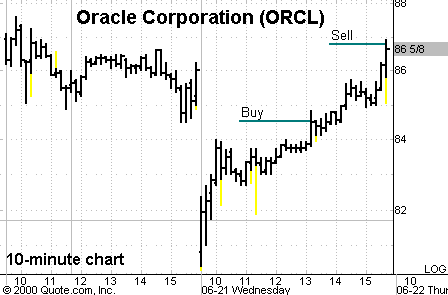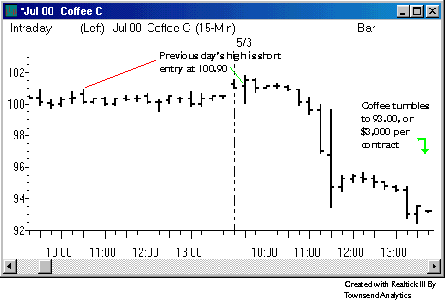Today’s Trading Lesson From TradingMarkets
Editor’s Note:
Each night we feature a different lesson from
TM University. I hope you enjoy and profit from these.
E-mail me if you have any
questions.
Brice
Four Rules For
Spotting And Exploiting News Reversals
By Daniel P. Delaney
Â
Just turn on
the TV or walk up to a magazine rack, and it becomes clear that the
business of reporting financial and business news has changed dramatically over
the last decade. We are bombarded by CNBC, the Nightly Business Report,
Bloomberg, and CNN Financial, minute by minute, about every late-breaking piece
of financial and economic news.
It’s no surprise, then, that all of
this media influence and attention can move the markets. The amazing part of
this whole process, however, is how often what should happen, doesn’t happen,
and what shouldn’t happen, does happen. Often, when the financial media
dramatically report a piece of news that should send a stock or index soaring,
the exact opposite effect occurs, and the stock or index gaps up, only to sell
off sharply on news that you would think would have had the opposite effect.
This process allows an astute trader to trade these “news reversals,” by taking
advantage of the “herd mentality” that the financial media continually stirs up.
| “The amazing part… is how often what should happen, doesn’t happen… (allowing) the astute trader to… (take) advantage of the ‘herd mentality’ that the financial media continually stirs up.” |
This trading method requires a major
news event to trigger a buy or sell signal. By trading news reversals, you can
learn to take advantage of the fact that the majority of people are rational,
and that they tend to react logically in the same way to the same outside
stimuli. Because human beings are basically rational, the collective result of
all of their actions can tend to cause an
over-reaction in the market.
It’s not that the market itself is
irrational, but rather it is just reflecting the sum total of a massive group of
people all thinking the same way, at the same time. This effect is only
compounded by a financial news media that is more than happy to rev-up the
crowd’s emotions.
For example, if a stock market is
nervous about inflationary pressures, and a piece of key economic data is
released showing a big spike in unemployment, the equity market will take it as
a very bullish signal and will likely gap higher. The media will fuel the
bullish sentiment, analysts and experts will make positive statements, and
traders and investors may launch into a buying panic. This obviously will cause
the market to gap higher at the open, creating a short-term overbought
condition.
Instead of moving higher, prices begin
moving lower, and selling leads to more selling. Speculators who thought prices
could only go higher begin to panic, and suddenly, what should have been a
bullish day for stocks turns into a large selloff, as prices head lower.
In order to implement a proper
news-reversal trading strategy, I have included some rules that TradingMarkets
CEO and founder Larry Connors wrote about in Investment Secrets of a Hedge
Fund Manager (M.
Gordon Publishing).
The Rules
Rule #1:
Wait for an extremely bullish or bearish event to occur after the market has
closed. Equity traders can look at analyst actions, earnings reports, or
takeover rumors. Futures traders can look for crop reports, weather reports,
economic reports, or livestock reports.
Rule #2:
Watch for the market to gap open above or below the previous day’s high or low
for a signal to occur.
Rule #3:
On openings that gap higher, place a sell stop one tick below the previous day’s
high. On openings that gap lower, place a buy stop one tick below the previous
day’s low.
Note: Equities cannot be purchased via buy stops. They must be done manually.
Rule #4:
After you are filled, stops should be placed at the morning’s opening price. As
prices move in your favor, stops should be adjusted to lock in profits.
One example of how the news-reversal
strategy can work is Oracle (ORCL).
After the bell on June 20, 2000, it announced better-than-expected earnings.
Despite the fact that Oracle beat analyst expectations of 25 cents a share by 6
cents, worries about future revenue growth and a downgrade from a major wire
house sent the stock sharply lower in after-hours trading.

As you can see, Oracle gapped lower at
the open on June 21, but the reaction to the downside turned out to be a classic
over-reaction that was fueled overnight and pre-market by a overly zealous
media. By the close on the 21st, Oracle was in positive territory. Your buy
would have been at 84 1/2 and would have been good for a couple of points.
In talking to Larry Connors about
news-reversal strategy, he said he has certainly found that it works even better
on futures than on stocks, due to the fact that futures have less intraday noise
and trade much cleaner than stocks.
A good example of a futures
news-reversal setup took place in July Coffee (KCN0)
futures on May 31, 2000 as is indicated on the chart below. Coffee gapped open
on news that exporters were reducing production by 20%.

Coffee gapped open to 101.25. The sell
stop would have been placed at the previous day’s high of 100.90 and would have
executed in early trading on the 31st. Prices then collapsed down to 93.00,
leaving traders with a winning trade of $3000 per contract trade for the day.
(The red line above indicates the previous day’s high, and the green line shows
where the entry trade would have occurred on the 31st).
Points To Remember
The main thing to remember about
trading news reversals is that it can be a psychologically difficult strategy.
When the financial media and all the “experts” reinforce the logical reaction to
a news event, it’s tough to trade against that reaction. You really can’t use
logic to trade this strategy. For example, it is hard to put in a buy stop in
bonds when the so-called experts are saying bonds are going to go down.
The key to trading news reversals is
to remember that you must toss out all of your preconceived notions in order to
truly listen to the market when it is acting like a contrarian. After all, the
market seldom seems to do what it is logically supposed to do, so developing the
ability to trade by using this reverse logic can give traders an edge, when “the
herd” is thinking logically
